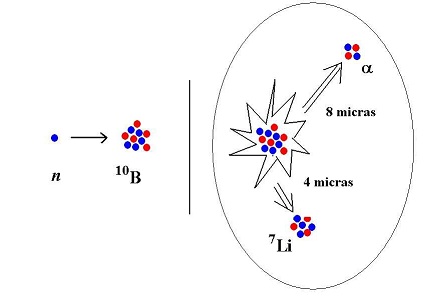Neutron Capture Therapy of cancer
Boron Neutron Capture Therapy (BNCT) is an experimental form of radiotherapy which is based on the selective accumulation of a stable isotope of Boron (10B) in the tumor and the irradiation with low energy neutrons. This isotope reacts with the neutrons and emits heavy charged particles of high energy, which is delivered in a region of the order of a cell size.

The resulting particles have a much higher linear energy transfer (LET) than electrons and photons (used in conventional radiotherapy) and, for this reason, a much greater biological effectiveness. Therefore a high radiation dose can be delivered at the tumor while keeping a low background dose in the surrounding healthy tissue. This is specially interesting for disseminated tumors and/or tumors which are resistant to conventional radiotherapy. In addition to this, clinical trials have shown that BNCT is an option for recurrent malignancies that have been previously treated with conventional radiotherapy and for which a second treatment of this type is not possible.
The success of this technique, which is the only radiotherapy modality intrinsically selective at the cellular level, depends critically on the concentration of the isotope in the tumor and the tumor/normal tissue concentration ratio. Given the concentration in both tissues, a Monte Carlo simulation of the radiation transport in a body phantom permits the prediction of the radiation dose delivered in each tissue and therefore the therapeutic ability.
In the clinical trials that have been done up to now, mostly for one of the deadliest brain tumor, the glioblastoma multiforme, only two boron compounds have been used. These are: sodium mercaptohydro-closo-dodecarborane (B12H11SHNa2, called BSH) and boron-phenylalanine (BPA). The first compound has a greater boron content but a much smaller tumor affinity, while the second has found to accumulate selectively in gliomas, melanomas or head and neck tumors with weight concentrations 3-4 times greater than in normal tissue. With respect to the neutron sources, only beams obtained from research fission nuclear reactors have been employed up to know. These are facilities that cannot be built into hospitals and therefore this is a limitation for the widespread of the technique. However, the new projects of producing the neutron beams from accelerators may lead to a new era in BNCT.
The most recent clinical trials reported very promising results, specially for Head & Neck cancer (Helsinki and Japanese groups). Other clinical trials have been performed in Argentina (malignant melanoma) and Pavia (liver metastasis).
Because of the solid scientific principles in which is based, I am personally convinced that neutron capture therapy will become in a future one of the best treatment options for different tumors of very bad prognosis.
I am coordinating the formation of a Spanish group for the research in BNCT. In this group currenty take part the Institute of Material Sciences of Barcelona (Dr. Rosario Núñez) for the research of new boron compounds, the Center for Biomedical Research of the University of Granada (Dr. M. Carmen Ruiz) for in-vitro studies, the National Accelerator Center (CNA) of Seville (Dr. Javier Praena) for epithermal neutron production and the pioneering study of sulfur-enhanced BNCT and researchers from the Department of Radiology of the University of Granada (Prof. Mercedes Villalobos) and the University Clinical Hospital "San Cecilio" for radiobiology studies. The private company LAIMAT is contributing to this R&D by means of the study of biotransporters. For this research we have been financed from the Campus for International Excellence BioTic of Granada and from the Junta de Andalucía (projects of excellence research).
A recent work of mine consists of the study of a different isotope (33S) as a alternative/adjuvant to 10B for neutron capture therapy. It could produce an enhancement of the tumor dose near the surface in BNCT treatments or applied to superficial tumors as ocular melanoma. This has lead to the publications:
[1] I. Porras, Phys. Med. Biol., 57, L1-L9 (2008). Link
[2] I. Porras, Appl. Radiat. and Isot. 69, 1838-1841 (2011). Link
The potential application of sulfur-33 in BNCT has been one of the motivations for a measurement of the (n,alpha) cross section at the neutron time of flight facility at CERN, which has been led by Javier Praena (CNA, Seville). See the document at CERN
In addition to this, I am currently interested in the determination of optimal neutron beams for BNCT obtained from accelerators. For this purpose Monte Carlo simulations of the neutron transport in tissue and the calculation of the radiation dose will be performed.
Also, the determination of the biologically-equivalent dose in BNCT is an open problem of our interest, because neutrons deliver the radiation dose by means of different secondary particles with different biological efectiveness. We will study the relative factors of these.
Ver todas las publicaciones del grupo de investigación de la UGR en BNCT: Link